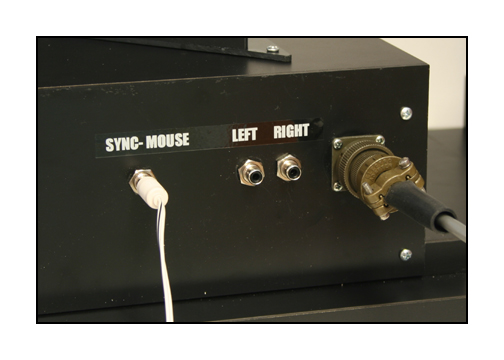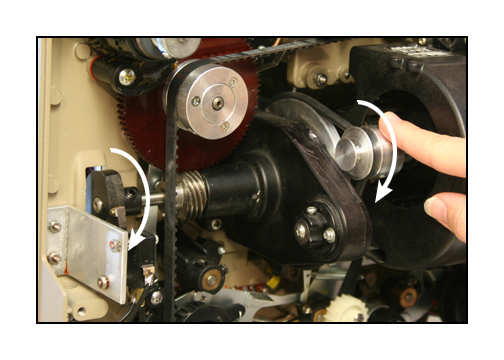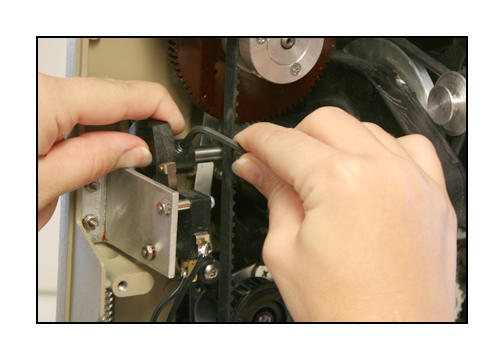WorkPrinter-16
HD Instructions
For use with a PC or Mac using the SyncMouse
NOTE: If international on 220VAC
at 50 cycles, you will need a
transformer that outputs 110-120VAC
at 250 watts.
You will need a Mac or PC with three internal drives.
One drive should be your system drive and the other two should be set up
in a Raid-0 drive array. Failure to use an internal Raid-0 array can result
in a loss of sync on the captured file. Drives should be ATA or Ultra-ATA
for your Raid. SATA drives do not work well for rapid stop motion capture
due to mechanical differences in how serial drives cycle compared to parallel
drives.
For the Mac, you will need the CaptureMate software.
For the PC, you will need CineCap software.
Both are available only to MovieStuff customers that
have received their WorkPrinter units shipped directly from MovieStuff.
Please email us with the
name and email address that was on the order form used to purchase the
WorkPrinter unit and we will email you the private purchase link for either
the CineCap or CaptureMate software. To maintain your warranty and customer
support, we ask that you please do not publically post this purchase link
on the web. Thanks.
After unpackaging the
unit, place on a sturdy and stable surface.
The end with the condenser
lens should allow for a tripod to be placed
about a meter or less
from the unit with clearance enough
for the tripod legs.
The tripod should have an adjustable height via
a column and the head
should allow for seperate horizon and tilt functions.
Ball-head tripods
should be avoided.
First, install the
condenser lens.
(glass should be cleaned
with non-alcohol products and a clean, cotton cloth)

Next, connect the cables
as shown.

The white cable is
from the special sync-mouse provided.
The large multi-pin
cable is found coiled in the back of the projector.
Next, load some film
into the unit as shown and
switch on the power.

With the motor switch
"off", turn the control knob
to the play position
to close the gate.
Run the motor switch
briefly to seat the film and to proceed to a
bright, well exposed
frame.

Make sure the selector switch on the WorkPrinter is
in the middle (off) position.
Make sure that the sync mouse is the only mouse plugged
into your computer. Then turn on your computer. Make sure the camera is
mounted on a tripod (column type is best) and is level and centered in
approximate height with the condenser lens. Also, make sure that you can
see the resulting, live image on a large monitor. Using the tiny LCD monitor
on the camera will make critical adjustments tough. Use of a broadcast
underscan monitor is ideal because it will let you see the edges of the
video frame for proper cropping of the image. Consumer TV monitors do not
let you see the entire video frame, which can result in improper cropping
and unlevel images. As a substitute for an underscan monitor, you can use
the capture window of your favorite video editing program, which usually
shows about 99% of the video image.
Make sure your camera is not set to any "auto shutter"
or “steady shot” positions. At a minimum, 60th of a second speed
should be used for NTSC or 50th of a second for PAL. Higher shutter speeds
will make setting the timing on this unit easier.
NOTE: If using an HD camera in the SD mode, you will
need to set your shutter speed to 1/500th of a second or higher
to overcome the latency inherent in CMOS imaging chips.
Avoid using progressive scan or "frame mode". Just
the normal interlaced video mode is needed. Best results and best registration
is achieved if your film has been freshly cleaned and lubed with good splices
and no torn sprocket holes. Supply reels should be inspected for warpage
or anything that will impede the even feed of film from the reel. Feed
reels that bind or grab the edges of the film may cause registration problems
or even film damage. Head leader should be fairly straight without a lot
of "curl memory" that will impede proper loading.
Various films have
different frame line placements. To make minor adjustments
in the vertical positioning
of the frame, use the adjustable foot at the front of
the projector as shown.

Position the camera
about 2.5 feet from the lens. Look at the monitor
for distortion of
the image. If there is curvature of the image top and bottom
then you need to adjust
the focus knob of the projector to correct. This will make the image
go out of focus, which
is normal. Always reclaim your focus using the camera lens.
Never use the projector
focus knob to adjust focus. The projector
focus knob should
only be used to correct for distortion.
NOTE:
It should be noted that the focus can be adjusted
in two different ways: your camera and the projector. In fact, because
there is no screen, the lens of the projector, the condenser lens and the
camera lens are all working as one, big lens. Moving elements to different
positions will create different results. If you zoom in and find that you
can fill the frame but can not focus at all or evenly via the camera, set
the camera focus as best you can and then adjust the focus of the projector.
Ultimately, there is little I can tell you here about
how to set your focus as every camera is different. You will have to experiment
with your set up until you get it right. I can tell you that you should
be able to get it sharp edge to edge with no chromatic aberrations and
no distortion or pin cushion. Just remember that you have several ways
to attenuate the image by using the projector focus and camera focus in
combination. Once you feel you have achieved the desired result, zoom your
camera in to rid the image of the edges of the gate and refocus. The image
should be sharp edge to edge and corner to corner with no hot spot nor
any chromatic aberrations. If the edge of the frame goes dark when you
zoom in, just adjust the placement of the camera side to side (not panning,
but actually moving the camera) ever so slightly until you restore even
illumination.

Exposure can be adjusted
using the PRESET knob.

To begin capture,
launch your capture software and verify that you have an image
in the capture window.
Type the appropriate file information and then
place the cursor over
the capture button and leave it there.
Turn on the motor
switch to start the projector running. Then turn on
the sync switch to
the "SYNC MOUSE" position.
The on-screen capture
button should begin "clicking" on its own.
After capture, review
the footage on regular television monitor to look for pulldown
blur. A computer monitor
should be avoided for critical review during this process
because computers
and macs will notoriously drop a field to accomodate
the display of interlaced
video. If you have pulldown blur that exists on a field
that is beind dropped,
you will not see it. But you will see it on regular interlaced
television monitor.
Pulldown blur is caused
because the film was captured during motion instead of
stationary in the
gate. Every camera/computer combination has a slightly different
timing characteristic
so there is no way for us to "pre-set" the timing.
To adjust the timing,
remove the back cover by taking out the various screws
edge of the
cover. Near the front you will see a small timing disk.
To get to the timing
disk set screw, you may need to rotate the motor pulley;

Loosen using a small
hex head wrench.

Once you loosen the
screw, turn the timing disk on the shaft to a new position.
Re-tighten the set
screw to hold the new position. Do not over-tighten
or you will crack
the plastic timing disk.
Repeat a capture and
then review the file to look for pulldown blur, etc.
If your timing is set
correctly, you will have no noticable pulldown blur.
If your timing is
set incorrectly, you will have blur that comes and goes randomly.
It is not unusual
to have to turn the timing disk almost 360 degrees from the
initial position.
Again, there is no "pre-set" position. Every set up is different.
As noted on the website,
your Mac or PC should have three drives. One drive should
be your system drive
and the other two should form a Raid-0 drive array. All should
be internal and no
external capture drives should be used. SATA drives should be
avoided for your Raid
for best results, if possible. Make sure that all other programs
are shut down during
the capture process. No screen savers, no minimized programs,
no active network
cards, etc.
Once you have your
timing set, you can then capture and process the files through
your software for
speed changes, etc or you can do it on your NLE afterwards.
If you need, you can
reduce the speed of the WorkPrinter by changing belt position.
To lower the speed,
remove the back cover and locate the motor drive pulley.
Use the same hex head
wrench to loosen the set screw.

Slide the pulley toward
the motor and move the belt
to the smaller groove.
Make sure the belt is straight and gently,
but firmly, tighten
the set screw.

Feel free to contact
me if you have any questions! 830-966-4664
Roger



